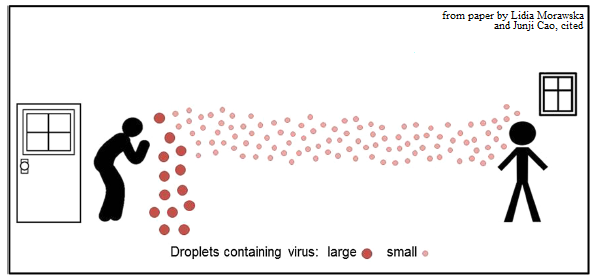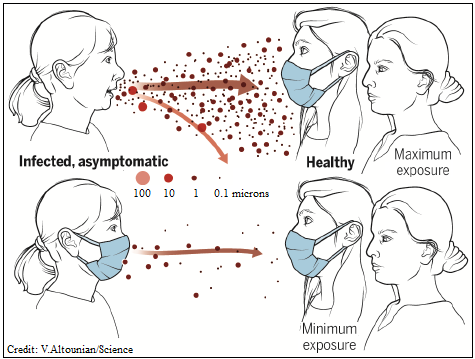Six feet apart may not be effective social distancing says S.Ananthanarayanan.
Lockdown, in the context of Covid-19, serves a purpose of letting communities get organized. As means of control, however, it is wasteful, as the contact it prevents is mainly between healthy people. The more efficient way is to identify and isolate infected persons
As the more efficient way has proved out of reach, the fallback is to ensure distance and protection, so that there are barriers to prevent the spread of disease, but to allow society to function. The economic and personal costs of lockdown are hence inducing states and communities to relax restrictions and permit a level of commercial activity, albeit with safeguards.
Kimberly A. Prather, Chia C. Wang and Robert T. Schooley from the Scripps Institute of Oceanography and the School of Medicine, University of California at San Diego, and the department of Chemistry and the Aerosol Science Research Centre, Sun Yat-sen University, Taiwan, explain in the journal, Science, recent findings of how COVID-19 spreads and the extent of precautions that are needed when communities and cities get back to work.
Respiratory infection, the paper says, happens when virus-containing droplets, exhaled when infected persons cough or sneeze, or smaller droplets when they breathe or speak, are transmitted. And the manner of causing infection depends on the droplets’ size, the paper says. The larger droplets are 5-10 microns in size, and smaller droplets are suspended in the air, in the form of an aerosol (or a solution in the air). Humans produce respiratory droplets that range from 0.1 micron to a millimeter in size. Droplets larger than 5 microns stay as droplets, the paper says, because they fall to the ground or other surface before they evaporate. These are the droplets that deposit viruses on different surfaces, where the virus may remain for hours or days.
Droplets that are smaller than 5 microns evaporate, and the viruses they contain stay suspended in the air, as an aerosol. And these particles can stay airborne for hours. While the traditional method of preventing spread respiratory diseases has been to contain transmission by larger droplets, the paper cites studies that say much of the transmission of Covid-19 has been through aerosols produced by individuals who may have been asymptomatic. The contact tracing exercises, performed by listing persons who came into ‘close contact’ with one who develops the disease, hence often fail to establish a source (although it alerts those contacts) and it is apparent that many infections were acquired from longer distances, one of the cited studies says.

In addition to contributing to the extent of dispersal and mode of transmission, the size of respiratory droplets has been shown to affect the severity of disease,” the paper says. The influenza virus, when carried in aerosols of less than a micron, is known to cause more severe infection. In Covid-19, the paper says, it is possible that the smallest aerosols reach the deepest parts of the lungs, temporarily bypassing immune responses. The Covid-19 virus, which multiplies three times faster than the SARS virus, can then spread to the pharynx, from where it would enter the environment, when the patient breathes, speaks or laughs – all before the immune system gets active and symptoms begin to show. The paper cites a study which says undiagnosed cases of COVID-19 infection, with ‘mild, limited or no symptoms’, were responsible for up to 79% of viral infections in Wuhan!
But severity of the disease apart, what current studies of the role of aerosols underline is that transmission through the air is a potent route for infection. Much attention so far has been, and correctly, on washing hands, not touching the mouth, nose or eyes and not shaking hands when we meet. And we have been warned to take care of surfaces, particularly metal surfaces, which are called fomites, where the virus can live for hours or days. Current studies, however, show that asymptomatic persons, admittedly, they do not cough or sneeze, can be highly infective, passing infection through their breath.
The World Health Organisation guidelines of 6 foot distancing and hand washing, the paper says, are based on studies which were carried out on respiratory droplets in the 1930s. These studies showed that droplets around 100 microns in size, in coughs and sneezes, quickly fell to the ground. The technology available did not permit study of aerosols. Now we know that a large droplet settles in 4-5 seconds, but a 1 micron particle stays airborne for over 12 hours. We also know that coughs and sneezes can deposit droplets 20 feet away and create thousands of aerosols that travel much further. The evidence shows, the paper says, that the 6 foot prescription may be inadequate in closed spaces, where aerosols accumulate, and drift.
How virus aerosols behave outdoors has not been studied, the paper says. While they would be transported by air movements, they would also be diluted, and sunlight, warmth and humidity may affect them. In polluted environments, viruses could attach to particles, such as of dust, which would keep them for longer in the air and help them spread. There are no studies of how fast viruses lose infectivity, but cases of Covid-19 have been found to be more severe in polluted areas, the paper says.
In enclosed spaces, however, it is clear that the viral load in the air, if there is an asymptomatic person in the room, increases every minute. Much ventilation is thus paramount and then, air-conditioning, which recycles the air, is a true step-in-aid to spreading infection. It is indoors where a well-fitting mask is important, the paper says, and being more than 6 ft away from another person is not good enough.
“Airborne spread from undiagnosed infections will continuously undermine the effectiveness of even the most vigorous testing, tracing, and social distancing programs,” the paper says. It was this realization that spurred the WHO to recommend universal use of face masks. Countries that have been most effective in reducing the spread of COVID-19, including Taiwan, Hong Kong, Singapore, and South Korea, have implemented universal masking, the paper says. And the paper cites a formal study that shows home-made masks with multiple layers and proper fitting can provide good protection from aerosols.

The high incidence of Covid-19 spread by asymptomatic persons and through aerosols calls into question both the value of testing only persons who show symptoms as well as measures of distancing, when lockdown restrictions are relaxed. The realization, however, does not reduce the danger from fomites, and the need to wash, and not touch. What it adds is the importance of masking, and being aware – the last line in our communications is often, “be safe”. What would be more practical is to say, “be alert”.
------------------------------------------------------------------------------------------ Do respond to : response@simplescience.in-------------------------------------------